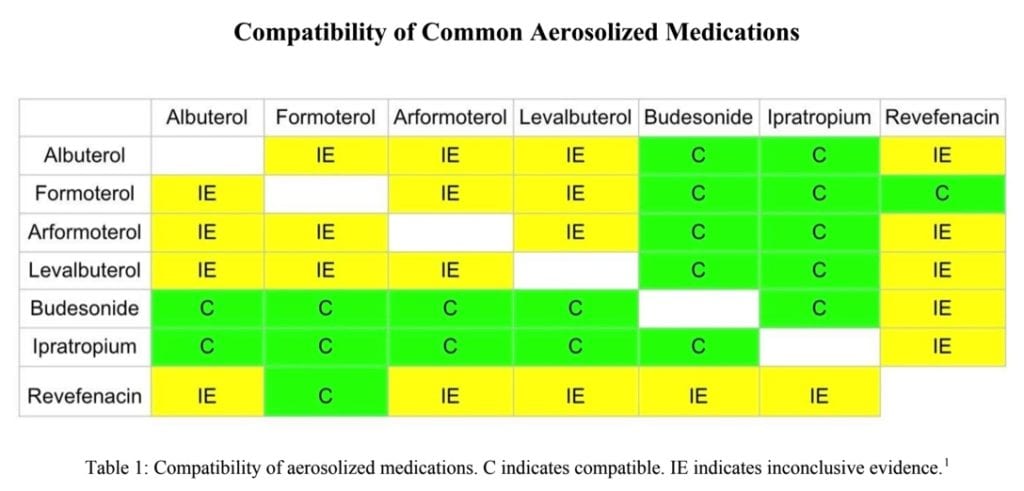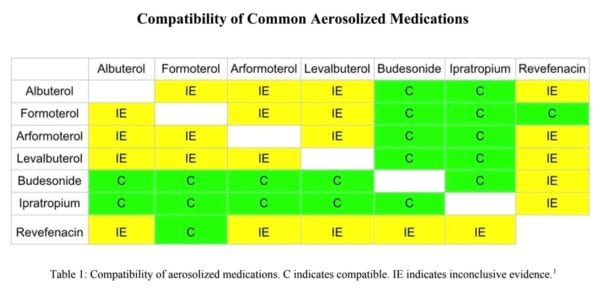The administration procedure for inhalation therapy with nebulizers can be very lengthy and time-consuming. Because of this, many providers, pharmacists, nurses, and respiratory therapists could benefit from knowing which aerosolized medications may be combined to shorten this process. Patients also often ask, “Can I Mix Nebulized Medications”? There tends to be limited data and resources that are readily accessible to determine which medications should or should not be mixed together. Fortunately, there are clinical trials that have pieced together which medications may be safely administered at the same time.
Albuterol is a very common short-acting beta-agonist used in nebulizer treatment. A study published in the Journal of Cystic Fibrosis in 2006 looked into the physical and chemical compatibilities of various medications that are commonly nebulized. One of the methods used to determine compatibility was chemical stability, which is considered < 10% degradation of each active substance. Albuterol was shown to be compatible with ipratropium (< 10% loss) and budesonide (< 10%). Levalbuterol was shown to have similar compatibility with both ipratropium (< 10% loss) and budesonide (<10% loss). More information about this study can be found here.
Formoterol and arformoterol are common long-acting beta-agonists used in COPD treatment. A study completed in 2008 determined that both of these medications are physically and chemically compatible with ipratropium and budesonide. It is important to note that although there are no physical and chemical incompatibilities, there was a significant increase in the amount of drug delivered in one nebulization. More information about this study can be found here.

Revefenacin is a newly approved long-acting muscarinic antagonist. A recent study analyzing the compatibility of revefenacin and formoterol looked at changes in appearance, osmolality, pH, purity, and levels of degradation. Based on this information and the stability of the two drugs, it was determined that they may be used in combination without loss or degradation. Because this is such a new medication, it is unclear whether or not it may be mixed with other commonly used inhalator treatments. More studies and data must be collected to accurately determine compatibility. More information about this study can be found here.
An article published in the American Journal of Health-System Pharmacy Journal summarizes which medications are compatible, which ones should be mixed, and which ones have inconclusive data (Table 1). This information was collected from a 2006 and a 2013 study published in the Journal of Cystic Fibrosis. In order to determine which medications are mixable without causing incompatibilities, a number of variables were analyzed. They confirmed physical compatibility through visual inspection, measuring pH, and osmolality. The researchers also measured chemical compatibility as well as aerosol characteristics to ensure the solutions were compatible. Lastly, information was pulled from various literature databases such as Medline and International Pharmaceutical Abstracts as well. In table 1 shown above, the medications that have been classified as compatible have a green “C” to indicate that they may be mixed together. Those with a yellow “IE” indicate that there is inconclusive data, meaning those combinations should be avoided. More information about this study can be found here.
Although there are no major references for the compatibility of nebulized medications as there are with the compatibility of intravenous medications, there are quite a few studies that can be looked at and summarized. The ones listed above cover many of the more common medications and should help to determine whether or not it is safe to mix them together when administering aerosolized nebulizer treatment.
Article written by Baley Pederson, PharmD Student with editing and proofing by Eric Christianson, PharmD
Love the blog? Over 6,000 subscribers now follow! Get my FREE 30 Medication Mistakes PDF for following!
- Burchett DK, Darko W, Zahra J, Noviasky J, Probst L, Smith A. Mixing and compatibility guide for commonly used aerosolized medications. American Journal of Health-System Pharmacy. 2010;67(3):227-230. doi:10.2146/ajhp080261
- Kamin W, Schwabe A, Krämer I. Inhalation solutions: which one are allowed to be mixed? Physico-chemical compatibility of drug solutions in nebulizers. J Cyst Fibros. 2006;5(4):205-213. doi:10.1016/j.jcf.2006.03.007
- Akapo, S., Gupta, J., Martinez, E., McCrea, C., Ye, L. and Roach, M., 2008.
Compatibility and Aerosol Characteristic of Formoterol Fumarate Mixed with Other Nebulizing Solutions. Annals of Pharmacotherapy, 42(10), pp.1416-1424. - Ngim K, Patel J. Physicochemical Stability and Compatibility of Revefenacin (LAMA) and Formoterol Fumarate (LABA) Inhalation Solution Admixture. Int J Pharm Compd. 2020;24(3):242-245.
- Kamin W, Erdnüss F, Krämer I. Inhalation solutions–which ones may be mixed? Physico-chemical compatibility of drug solutions in nebulizers–update 2013. J Cyst Fibros. 2014;13(3):243-250. doi:10.1016/j.jcf.2013.09.006
Originally posted on: https://www.meded101.com/can-i-mix-nebulized-medications-including-revefenacin/

